WordPress Traffic Automation Guide
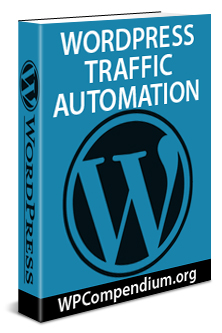 This tutorial is part of an article series aimed at helping you learn how to grow your business online inexpensively with a WordPress website or blog and proven web marketing methods.
This tutorial is part of an article series aimed at helping you learn how to grow your business online inexpensively with a WordPress website or blog and proven web marketing methods.
***
WordPress Traffic Automation Blueprint – Overview
 Traffic is the lifeblood of almost every business online.
Traffic is the lifeblood of almost every business online.
Discovering sustainable ways to generate more traffic to your website is essential to growing a successful web presence. Lack of online visitors is also one of the most common complaints made by website owners everywhere.
Why Do So Many Businesses Have Difficulty Attracting Traffic To Their Websites?
Type in any of the following key phrases into Google …
- “attract more web traffic to my site for free”
- “drive traffic to my website”
- “top 5 places to increase web site visitors”
- “ways to attract visitors using solo ads”
- “bring more clients to your website”
… and you will immediately find loads of information on methods to get more visitors to your website …
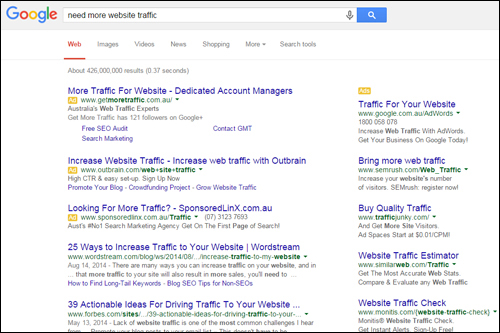
(There are many methods to drive more website visitors. In this article series you will learn how to set up a simple system to benefit from many of these traffic generation strategies!)
There is clearly no shortage of ways to drive more visitors to your site. There are loads of courses and free sites that can teach you cost-effective strategies to increase visitors to your web site.
The problem often has more to do with businesses not investing sufficient time into learning how to generate traffic sustainably, not setting up systems that allow them to manage the traffic generation process effectively, and, in many cases, not even being aware that there are things you can do to leverage and automate your web traffic generation.
The diagram below shows the approach most small businesses take when it comes to generating traffic to their sites …
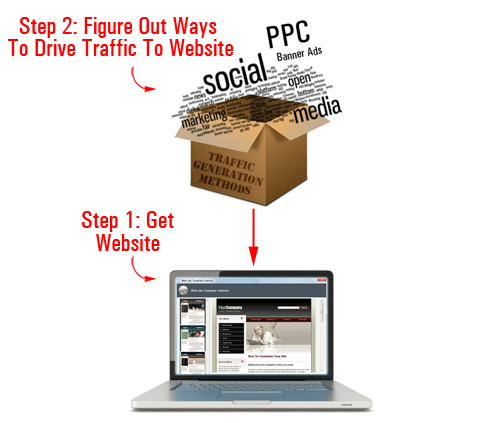
(This is how many website owners approach traffic generation)
Essentially, the approach most businesses typically take is this: first, you get your website, and then you figure out how to drive traffic to your website.
As we will show you in just a moment, there is a better approach.
![]()
You shouldn’t make the mistake of thinking that “outsourcing” your traffic generation will take care of the problem.
There is nothing wrong with outsourcing if you have systems set up to manage and process information about your traffic generation campaigns. If not, all you will probably do is end up wasting a lot of time and money looking for a winning traffic strategy.
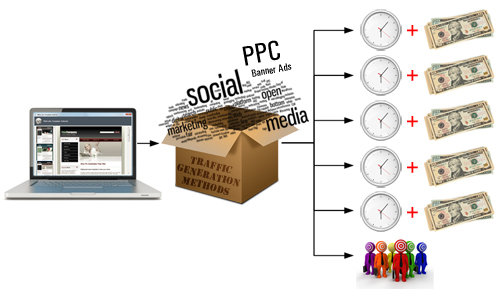
(Without a solid foundation and the right systems in place, online traffic generation can end up becoming very costly!)
Getting more web traffic sustainably requires laying a solid foundation online, putting systems in place, testing elements in your campaigns, experimenting with different methods, analyzing results, measuring ROI across different traffic generation methods, and so on.
Is There A Way To Automate The Process Of Getting Web Visitors?
Imagine if all you had to do to deliver an ongoing stream of web traffic to your website was to publish content consistently.
This is not fantasy or science fiction … it’s a fact! As a matter of fact, many website owners are already doing this … and so can you!
In the WordPress Traffic Blueprint article series, we will show you how to create an automated traffic machine that can help begin driving a stream of targeted traffic to your web site, simply by publishing regular content to your website.
How To Set Up A System That Will Automatically Bring Traffic To Your Website
As you can see in the diagram below, the web traffic blueprint we present in this article series involves 3 fundamental steps:
- Set up systems to lay down a solid foundation for creating sustainable traffic
- Add content on a regular basis to start bringing visitors and generating traffic data
- Test new traffic methods
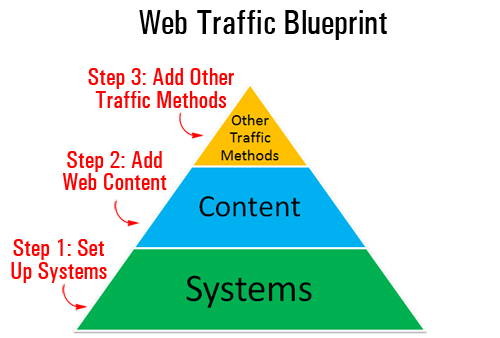
(Sustainable traffic generation involves setting up a solid foundation online and implementing proper systems)
At this stage, we’re mostly concerned with Step 1. The aim of this article series is to help you set up a traffic generation system that will ultimately:
- Save time using automation and leverage
- Save money by starting with a simple setup and scaling things in an economic and sensible way
- Automatically notify search engines
- Instantly notify and publicize your content to all of your social media accounts (e.g. Facebook, Twitter, Pinterest, etc.)
- Gain valuable insights about your traffic generation methods, track results, measure ROI, etc.
- Outsource traffic generation while maintaining full control of the process
- Grow your business online cost-effectively and sustainably
All of the above can be achieved using what we will refer to in this article series as an “expertly configured” WordPress website or blog …
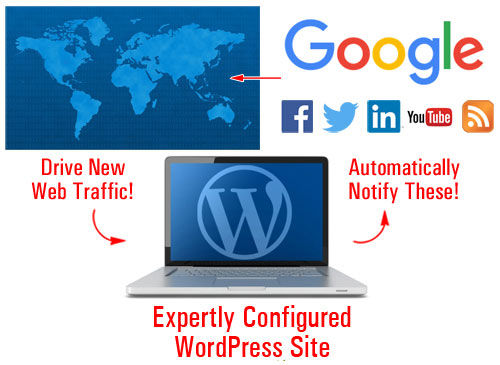
(With an expertly configured WordPress website, you just publish new content and your website will then do the rest, notifying the world about your content and bringing you back traffic!)
An Expertly Configured WordPress Web Site – What Is It?
An expertly configured WordPress website or blog is different than a professionally-configured WordPress web site.
An ”expertly configured” WordPress web site is a website that is not only driven by the WordPress CMS, but has also been expertly set up and configured (either by yourself or professionally) to take full advantage of the tremendous power, features and functionality of WordPress and its integration with other services, specifically in areas like search engine optimization, external site syndication, and analytics.
Why Use An Expertly Configured WordPress Site?
We write extensively on this site about the benefits of using WordPress-powered websites to grow your business online.
Understanding how and why an “expertly configured” WordPress web site can instantly drive targeted traffic to your business requires a number of articles, which is why we highly recommend that you spend some time reading our other articles and consider subscribing to this site (this way, we can let you know whenever we publish new content about this topic).
Let’s start by addressing some basic questions:
What makes WordPress so special? Why not use another web platform?
Take a look at the picture below …
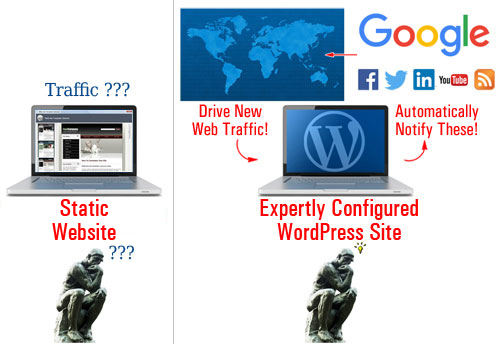
(Static vs Expertly Configured WordPress Website)
Many websites are built on applications that create websites with “static” web pages. Essentially, what this means is that the digital content typically sits inside a server waiting to be found. A static website doesn’t communicate with anything else outside its application; it doesn’t ’ping’ anyone in the cybersphere or inform any other website when new content has recently been published.
Think about it … if with a static website, all of the content simply sits in a server passively waiting to be found, then the web site owner has to keep promoting their website and its content to continue driving web traffic.
WordPress is different!
The WordPress platform provides many features that allow users to set up, configure and build an automated “web traffic generation” machine, where all you then have to do is post new content and WordPress will do the rest, instantly notifying search engines, social media and other online properties about your site to automatically start generating your business new web traffic …
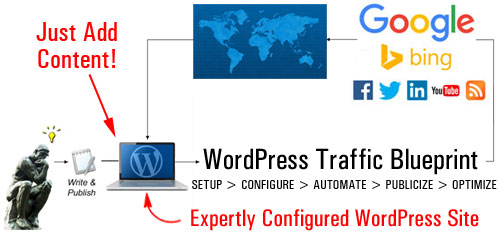
(With an expertly configured WordPress site, you just publish content and WordPress will do the rest!)
An Automated Content Distribution, Traffic And Lead Generation, And Sales & Marketing System
With an expertly configured WordPress site, you can build more than just a website for your business … you can set up an automated traffic and lead generation and sales & marketing system, where all you do is publish your content and WordPress then automates the rest …
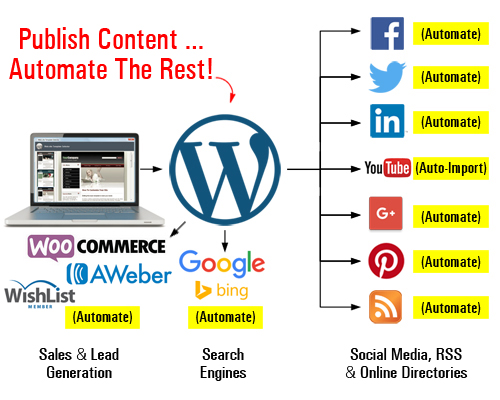
(Set up an automated content distribution, lead and traffic generation, and sales and marketing system with WordPress)
As your business evolves, you can add more functionality and automate processes like:
- Sell products and services with e-commerce,
- Capture leads with opt-in forms and add your subscribers to newsletters and autoresponders,
- Allow visitors to register on your site with different membership levels,
- And so much more!
You can do all of this using inexpensive WordPress plugins. Once these plugins are installed and configured on your site, just direct your visitors to the appropriate sections (e.g. your store, subscription forms, membership area, etc.)
The video below shows you what an expertly configured WordPress site can do for your business …
In Part Two of The Web Traffic Blueprint overview, we explain the components of this automated traffic machine:
- Setup – Learn the best way to get started if you don’t have a web presence yet, or if you already have an existing site that may or may not have been built using WordPress.
- Configure – WordPress already comes with a number of built-in features and settings to help you generate traffic. Learn what features and settings need to be expertly configured for optimal results.
- Automate – Your traffic machine not only requires expert configuration of internal WordPress settings but also integrating your WordPress site with third-party tools and other online properties (e.g. webmaster, analytics, and social media accounts).
- Publicize – After configuring your site settings and integrating your site with various external tools, you then begin to publish new content regularly and WordPress will instantly notify and inform search engines, your social media pages and other online properties about the new content, giving your site wider exposure online to potential new visitors.
- Optimize – We recommend starting with a content-based strategy to build traffic organically. With the right systems in place, you can also begin measuring and analyzing the traffic generated as a result and gather valuable information that will allow you to make smarter decisions when expanding to additional traffic generation methods.

This is the end of Section 1
To read the rest of this article, click here:
![]()
This article is part of a comprehensive series of tutorials designed to help small business owners learn how to grow their business online inexpensively with a WordPress-powered website and proven marketing methods that are easy to implement.
Get Notified When New Tutorials Are Published – Subscribe To WPCompendium.org!
***
"Learning WordPress has been a huge stumbling block for me. I've been looking for something that covers absolutely everything but doesn't cost an arm and a leg. Thank you so much ... you have just provided me with what I have been looking for! Truly appreciated!" - Tanya